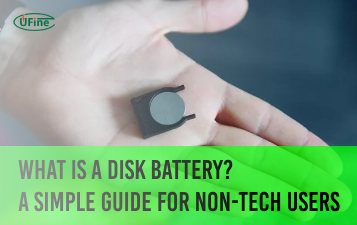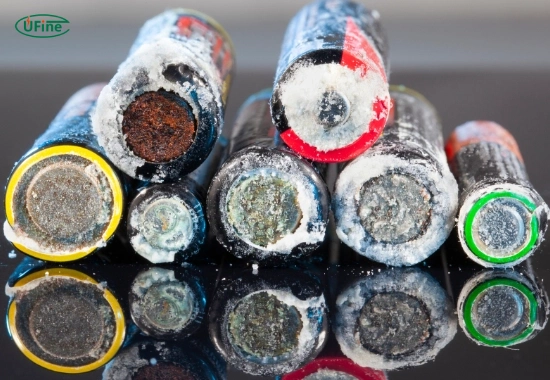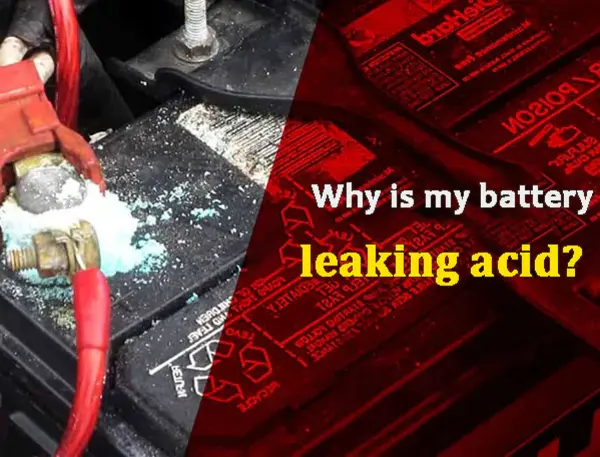Battery acid, also known as sulfuric acid, is a highly corrosive substance commonly used in lead-acid batteries found in cars, boats, and more. Mishandling it can lead to severe injuries and environmental hazards. This guide covers how to identify its distinct smell, why leaks occur, and step-by-step instructions for safe disposal to ensure your safety and compliance with environmental regulations.
Part 1. What is battery acid?
Battery acid, or sulfuric acid, is highly corrosive in lead-acid batteries. Commonly, people use these batteries to power vehicles like cars, trucks, motorcycles, and boats. Battery acid plays a crucial role in the functioning of these batteries by facilitating the chemical reactions necessary for generating electrical energy. However, it’s essential to handle battery acid with extreme caution due to its potential to cause severe burns and damage to skin, eyes, and clothing upon contact.
Part 2. The role of battery acid in power generation
Sulfuric acid interacts with lead and lead dioxide plates within the battery to produce electricity when using a lead-acid battery. This process, an electrochemical reaction, powers the vehicle’s electrical systems, including starting the engine and providing electricity for lights and other accessories. While battery acid is typically diluted with water to form an electrolyte solution, it remains highly corrosive and can cause harm if mishandled. Taking proper precautions when handling lead-acid batteries is essential to minimize the risk of accidents and injuries related to battery acid exposure.
Part 3. Why do batteries leak acid?
Common Reasons Batteries Leak Acid
1. Overcharging
Overcharging generates excessive heat, causing pressure to build up within the battery. This can result in cracks or ruptures, leading to acid leakage. To prevent this, use a quality battery charger with overcharge protection.
2. Physical Damage
Physical damage, such as drops or impacts, can compromise the battery casing. Regularly inspect batteries for cracks and avoid mishandling to reduce this risk.
3. Aging and Wear
Over time, batteries degrade due to repeated charging cycles. Replace aging batteries promptly to avoid leaks and maintain optimal performance.
4. Manufacturing Defects
Occasionally, poorly manufactured batteries can have weak casings. Choose reputable brands to ensure quality and minimize defects. For more tips, read our battery maintenance guide.
For tips on preventing leaks, read our guide on proper battery storage practices.
Part 4. What does battery acid smell like?Identifying the dangerous odor
Q: What does battery acid smell like?
A: Battery acid has a strong, sour odor resembling rotten eggs or burnt matches. This smell indicates potential leakage of sulfuric acid, which requires immediate action.
The scent is caused by sulfur dioxide gas released when sulfuric acid reacts with moisture. Overcharged or damaged batteries may also emit hydrogen sulfide (smelling like rotten eggs), which is toxic in confined spaces.
Why Does Battery Acid Smell Like Rotten Eggs?
The rotten egg smell is caused by hydrogen sulfide gas (H₂S) released when sulfuric acid breaks down due to overcharging or battery damage. This gas is toxic in high concentrations—if you smell it, ventilate the area immediately.
What to Do If You Smell Battery Acid? Emergency Steps
- Ventilate the area: Open windows and doors to disperse gases.
- Avoid sparks: Sulfur dioxide is flammable—turn off electronics.
- Inspect the battery: Wear gloves and goggles. Look for cracks or corrosion.
- Neutralize leaks: Sprinkle baking soda on spilled acid (see Part 5).
Part 5. What to do when batteries leak?
By following these steps, individuals can safely dispose of battery acid while minimizing the risk of harm to themselves and the environment.
How do you neutralize battery acid?
Before disposal, diluting battery acid with water is crucial to reduce its acidity. For safety purposes, always wear protective gear such as gloves and goggles. Carefully pour the battery acid into a large container filled with water, ensuring a dilution ratio of at least ten parts water to 1 part acid. Stir the mixture gently to ensure thorough dilution.
Neutralizing the Solution
After dilution, it’s essential to neutralize the solution to make it safer for disposal. You can slowly add baking soda or another neutralizing agent to the mixture while continuously stirring. Continue adding the neutralizing agent until it neutralizes the acid, indicated by the solution no longer fizzing.
Safe Disposal
Once neutralized, the solution can be safely disposed of by local regulations. Transfer the neutralized mixture to a designated hazardous waste disposal container or contact your local waste management facility for proper disposal. Never pour battery acid or its neutralized solution down drains, sewers, or onto the ground, as it can contaminate water sources and harm the environment.
Eco-Friendly Disposal Options
Many communities offer recycling programs for lead-acid batteries. Check with local recycling centers to ensure proper disposal. Recycling reduces environmental harm and supports sustainable use of resources. You can also consult battery retailers, as many offer disposal or recycling services.
How to clean a leaky battery?
After disposal, thoroughly clean and decontaminate any equipment or surfaces that came into contact with the battery acid. Use a solution of water and baking soda to clean affected areas, then rinse with water and dry thoroughly. Dispose of any contaminated materials, such as gloves or rags, by local regulations.
Part 6. Conclusion
Battery acid emits a distinct smell that people often describe as spicy and sour, resembling the scent of rotten eggs. This odor is a warning sign of potential battery damage, leakage, or the release of harmful gases. Suppose you detect the smell of battery acid. Handling the situation carefully and following proper safety protocols is crucial.
Part 7. FAQs
What color is battery acid?
Battery acid is typically colorless or slightly yellowish. However, it may appear cloudy if contaminated with lead particles from damaged battery plates.
Is the rotten egg smell from a battery dangerous?
Yes, the rotten egg smell indicates hydrogen sulfide gas (H₂S), which is toxic in high concentrations. Prolonged exposure can cause headaches, nausea, and respiratory issues.
Is battery corrosion toxic?
Battery corrosion contains lead sulfate and sulfuric acid residues, both of which are hazardous. Always wear gloves when cleaning and dispose of contaminated materials as hazardous waste.
Is battery acid dangerous?
Yes, sulfuric acid in batteries can cause severe chemical burns, blindness, and respiratory damage. Immediate flushing with water is critical for skin or eye exposure.
How do I store battery acid safely?
Store in a certified acid-resistant container, away from children and heat sources. Keep upright in a ventilated area, and label clearly with “DANGER: SULFURIC ACID.”
What should I do if I smell battery acid at home?
Immediately ventilate the area, put on PPE (gloves/goggles), locate the leaking battery, neutralize spills with baking soda, and dispose of it at a hazardous waste facility.
What happens if you touch battery acid?
Skin contact causes burns and tissue damage. Rinse immediately with water for 15+ minutes and seek medical help. Do NOT rub the affected area.
How long does battery acid smell linger?
The odor may persist for hours until the leak is neutralized. Thorough cleaning with baking soda and ventilation can eliminate the smell within 24 hours.
Can battery acid smell make you sick?
Inhaling sulfuric acid fumes or hydrogen sulfide gas can irritate the lungs and throat. Severe exposure may require hospitalization for respiratory support.
How to remove battery acid smell from a car?
1. Neutralize residue with baking soda paste. 2. Scrub with a nylon brush. 3. Rinse thoroughly. 4. Use an air purifier with HEPA filter to remove lingering particles.
Related Tags:
More Articles

What Is a Disk Battery? A Simple Guide for Non-Tech Users
A disk battery is a small, round cell used in watches, remotes, and other electronic devices. It delivers steady power for compact, low-drain devices.
What Battery Powers a Space Heater?
Discover the type of battery that powers space heaters and learn how to choose the right one for efficient heating in your home or office.
What Is an LR14 Battery? Learn About This C-Size Cell
The LR14 battery, also known as a C battery, delivers steady power. Learn its specs, uses, lifespan, and how it compares to other battery types.
Watch Battery Dimensions Chart: Sizes, Voltages, and Equivalents Explained
Understanding watch battery dimensions helps you choose the right size, voltage, and equivalent model to keep your watch running safely and smoothly.
How Long Can You Rely on Battery-Powered Generators?
Discover battery generator runtime & lifespan factors. Learn how to maximize performance and choose the right power solution.





